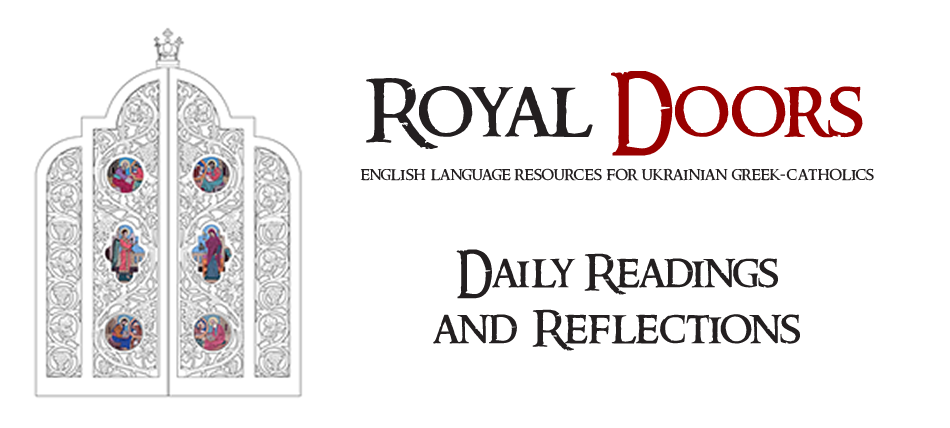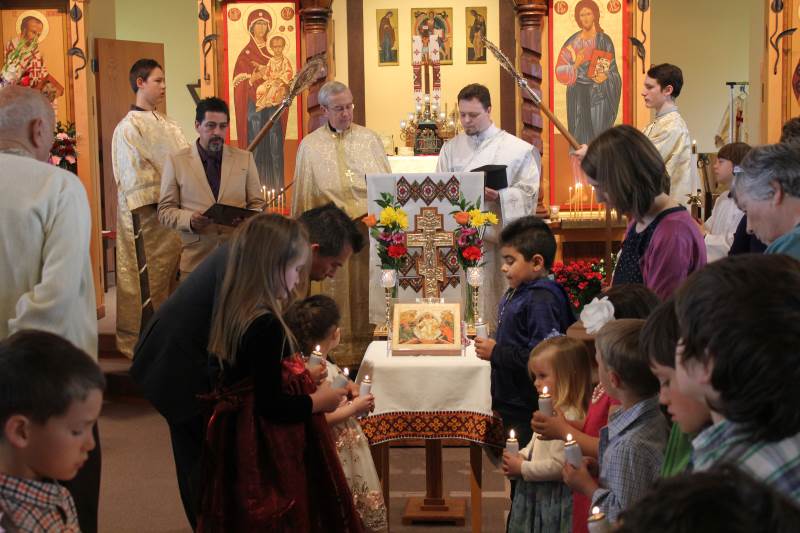by Brent Kostyniuk
In certain ways, it is easy being Ukrainian Catholic in a city like Edmonton. Ukrainians form fourteen percent of the population and have been there since the first Ukrainian pioneers arrived in the 1890s. The city is the seat of one of Canada’s five Ukrainian Catholic Eparchies and boasts nine Ukrainian Catholic parishes. No matter where you live in the city, there will be a parish within a short drive. Ukrainians are everywhere—you can even go into any grocery store and buy kobassa and frozen pyrohy. Church and heritage go hand in hand.
So it is that for many Ukrainian Catholics their Church is seen as an ethnic religion. It is the faith of their parents, grandparents, and ancestors for many generations before that. It is a Church for Ukrainians. However, it is much more. Patriarch Sviatoslav has said our Church should be open to all, and welcome anyone who wants to share our beautiful Byzantine faith and traditions.
Love the Ukrainian Way of Faith
Father Richard Janowicz is pastor of Nativity of the Mother of God Ukrainian Catholic Church in Springfield, Oregon, a parish where ethnic Ukrainians are the minority. He reflects on how the parish meets the spiritual needs of ethnic Ukrainians and non-Ukrainians alike. “When our parish life began in 1981, we had a mix of American-born, American-born Ukrainian, and Ukrainian-born parishioners. It was a wonderful group of people who had great respect for one another and were always ready to work together for the good of the parish. Several of the Ukrainian-born parishioners, including some who didn’t speak English, were insistent on using the English language, primarily, in the services. They all seemed to agree: ‘If we don’t use English, we will not have enough people to support a church, and we want a church.’ They were truly wise and were looking for a way to worship the Lord according to their tradition, even if it was (mostly) not in their native language.
“The non-Ukrainian people were happy to learn some Ukrainian for Liturgy, and even more so to learn about folk customs that accompanied the various holy days of the year. Many of them embraced these customs and made them their own. This, in turn, supported the cultural heritage of our foreign-born people and they felt a sense of honest pride that people of other cultures would take up and practice Ukrainian customs. In this way, each group supported the other group and parish life was good.
“Over the years our Ukrainian people have mostly gone to their heavenly reward and the newer immigrants are not interested in Church. But those ‘others’ in our parish, from different backgrounds, continue to sing Hospody pomyluj, bake pascha, decorate pysanky, and dance in our Ukrainian Veselka group for a concert every year. They love all these things, even while others who should naturally be loving them, stay outside our doors. More than that, they love the Ukrainian way of faith.
“People from ‘outside’ have come to our parish primarily because of the beauty and richness of the Liturgy and other services, and they also enjoy the close-knit ties of our parish, which are much harder to find in Latin churches. We are now in the third generation of some of these non-Ukrainian parishioners and they uphold the tradition we received from the Church of Kyiv very well. Their tie is not one of ethnicity or blood rather that of love for the culture and especially a firm faith which is practiced as it was for over 1,000 years in Ukraine. Glory to Jesus Christ!”
This is What we Sought
Claudia and Craig May are two of those Nativity parishioners who have come from “outside.” Claudia explains how they came to join Nativity parish and what it means to them. “My husband and I chose to be Ukrainian Greek Catholics because of the liturgical wholeness this beautiful rite offers. I converted into the Catholic Faith through the RCIA program and learned there were 22 additional rites [sic] within the Catholic Church, and one Ukrainian parish was in Springfield, just a few miles away! We are blessed we don’t have to travel far. However, some of our parishioners travel over 90 miles to attend our parish!
“I was intrigued by the incense—prayers rising up to heaven and the icons—windows into heaven. I was also pleased to see that children could receive all three Mysteries of Initiation at one time! We had five children at the time who were already baptized, and I loved the idea they all might receive Chrismation and Holy Communion. To me this fit with what the Lord said, ‘Let the little children come to me for to them belongs the Kingdom of God.’
“My husband and I knew that this is what we sought. We loved the beautiful back and forth response between the priest and the laity and how the Divine Liturgy invokes all the senses, through the sight of icons, the smell of incense, the taste of the Most Holy Eucharist, touch as we do the sign of the Cross and kiss the icons, and the sound of the hymns. All the senses are united in the worship of God!
“I love how holistic and organic our Ukrainian liturgy is. There is the flow of the seasonal and fixed Gospel and scriptural readings. We can tell pre-Lenten preparations are around the corner when Zacchaeus Sunday rolls around, or in some years beginning with the Pharisee and the Publican. There are the special occasions which are celebrated in distinct ways. The beautiful and joyful Baptisms, as well as Crownings in Sacred Matrimony have their unique rhythm. They all affirm that life is beautiful and a gift from Christ. There are the wonderful greetings and responses which vary with the season, such as the Paschal ‘Christ is Risen!’ and ‘Indeed He is Risen!’ Hearing them in Ukrainian or English is inspiring. All of these make the Faith real and easier for me and my family to live more fully during the week. These are constant reminders of how our faith is indeed tangible, and we should live it throughout all our day-to-day activities.”
The parishioners of Nativity of the Mother of God parish are living witness that the Ukrainian Catholic Church can, and should, be open to all who want to share in Her rich Byzantine Tradition and proof the Church does indeed breathe through Both Lungs.



